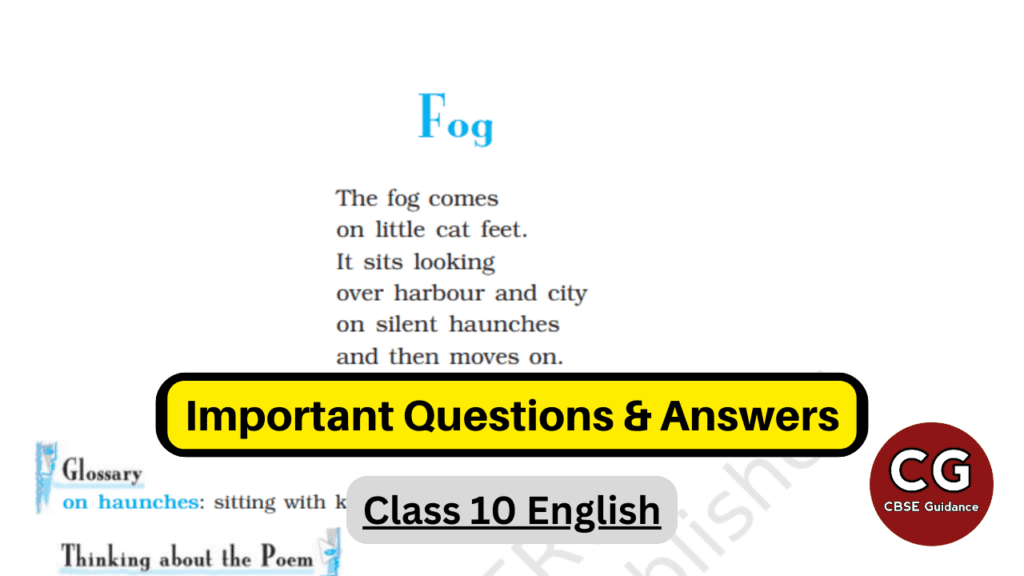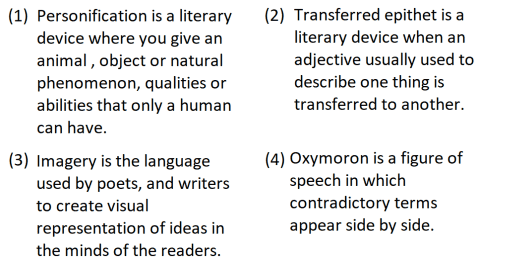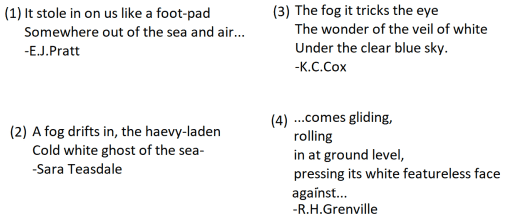Welcome to our comprehensive guide on mastering the poem "Fog" from Class 10 English First Flight book! Authored by renowned poet Carl Sandburg, "Fog" is a captivating piece that delves into the mysterious nature of this natural phenomenon. In this blog post, we'll delve into the key and extra questions and answers related to this poem, providing you with an in-depth understanding to ace your exams. Along with analyzing the poem itself, we've curated extra questions and answers to further enhance your comprehension. Plus, stay tuned till the end where you'll find a downloadable PDF containing all the study material covered. Let's embark on this journey of unraveling the beauty and significance of "Fog" together!

| Subject | English Language & Literature |
| Class | 10 |
| Board | CBSE |
| Chapter Name | Fog |
| Type | Important/Extra Questions and Answers |
| Session | 2024-25 |
| Book Name | First Flight |
| Literature | Poem |
"You are only entitled to the action, never to its fruits."
- Bhagavad Gita
Fog Class 10 Central Idea
The central idea of Carl Sandburg's poem "Fog" is the subtle and mysterious nature of fog. The fog is compared to a cat, emphasizing its quiet approach, observation, and eventual disappearance. The poem suggests that the fog is a symbol of mystery and uncertainty, and that the natural world can be both beautiful and unpredictable.
Fog Class 10 Important Questions Answers
Q. No. 1) Multiple Choice Questions based on an extract:
The fog comes
on little cat feet.
It sits looking
over harbour and city
on silent haunches
and then moves on.
i. Choose the option with qualities of the cat that Carl Sandburg applies to the fog.
- Cats are independent animals, they don’t follow rules, they slip and slide in and out of our lives as they please.
- Cats are distrustful of strangers and can be jealous and moody.
- Cats are stealthy, moving in slow motion at times and they appear to be moving in a mysterious fashion.
- Cats often communicate with a combination of a distinctive sound and body language.
- Cats like to move on at their own pace and before you know it, they've disappeared.
a) Only 1
b) 2, 3 and 4
c) 1,3 and 5
d) Only 4
Ans. Option (c)
ii. Which one/s of the following applies to the given lines?

a) 1 and 4
b) 2 and 3
c) Only 1
d) Only 3
Ans. Option (d)
iii. Pick the option that includes an image of the cat on its haunches.

a. Option (1)
b. Option (2)
c. Option (3)
d. Option (4)
Ans. Option (b)
iv. Choose the option that DOES NOT list the movement of the fog.

a. Option (1)
b. Option (2)
c. Option (3)
d. Option (4)
Ans. Option (c)
v. The poet has used short lines to compose the given poem. Choose the option that lists the most appropriate explanation for the same.
a. By keeping the lines short, the poet keeps the liberty in stepping away from rule, traditional form, logic, or fact, in order to produce a desired effect.
b. By keeping the lines short, the poet wants the reader to omit some parts of a sentence, which gives the reader a chance to fill the gaps while reading it out.
c. By keeping the lines short, the poet wants to introduce ambiguity or contradiction into an otherwise straightforward sentence.
d. By keeping the lines short, the poet is controlling the pace to make the reader slow down thereby reflecting the slow rolling in of the fog.
Ans. Option (d)
Q. No. 2) Read the given extract and answer the questions given
The fog comes
on little cat feet.
It sits looking
over harbour and city
on silent haunches
and then moves on.
(Fog)
i. In what way does the language used in this poem challenge traditional ideas of what poetry should be?
Ans. Unlike traditional poetry that often relies on complex rhyme schemes and metaphors, this poem uses simple, everyday language to create a vivid picture in the reader's mind to create a powerful and evocative mood.
[The learner is required to think critically about the poem and its relationship to traditional poetry. By examining the use of language and imagery in the poem, the learner can identify ways in which it challenges traditional ideas of what poetry should be.]
ii. What is the significance of the use of the word "little" to describe the fog in the poem and how does this word choice contribute to the overall mood and tone of the poem? Answer in about 40 words.
Ans. The word "little" used to describe the fog in the poem suggests the subtle and quiet nature of the fog. The word "little" also evokes a sense of innocence and vulnerability, as if the fog is a harmless creature moving through the city. This contributes to the overall mood and tone of the poem, which is calm and peaceful, with a touch of mystery.
iii. Complete the sentence with the appropriate option. The lines from the poem tell us that the city is ______.
a. hilly
b. coastal
c. industrial
d. under-developed
Ans. Option (b) [the evidence lies in the use of the word ‘harbour’]
iv. Identify the type of imagery used in the lines of the poem.
Ans. visual /animal imagery [allows the reader to visualize the fog and creates a sense of atmosphere in the poem.]
Q. No. 3) Highlight any two characteristics of fog from its description in the poem and justify your choice of characteristics briefly.
Ans. Two characteristics of fog highlighted in the poem are its quiet, stealthy movement ("on little cat feet") and its ability to envelop both natural and urban landscapes ("over harbour and city"). These characteristics evoke a sense of mystery and omnipresence, enhancing the atmospheric quality of the poem.
Q. No. 4) Stealth is an important aspect of fog. State any two instances from the poem “Fog” that suggest the same.
Ans. Two instances suggesting the stealthy nature of fog in the poem are its silent arrival ("on little cat feet") and its silent observation over the harbor and city.
Q. No. 5) Is the fog portrayed as a resident of the city or as an outsider? Support your answer with two such references from the poem “Fog”.
Ans. The fog is portrayed as both a resident and an outsider in the poem. It is depicted as a resident by sitting over the harbor and city ("It sits looking over harbour and city") but also as an outsider by its silent, fleeting presence ("moves on").
Q. No. 6) Why does the poet use the phrase “silent haunches”? Substantiate your answer with reference to the poem “Fog”.
Ans. The poet uses the phrase "silent haunches" to depict the fog's quiet and still posture, similar to a crouching animal. This personification adds to the mysterious and stealthy nature of the fog, emphasizing its ability to observe without making noise, as seen in the line "It sits looking over harbour and city on silent haunches."
Q. No. 7) Would you describe the role of the fog as active or passive? Support your answer with reference to the poem “Fog”.
Ans. The role of the fog in the poem appears to be passive. It is depicted as quietly enveloping the harbor and city ("It sits looking over harbour and city on silent haunches") and then moving on without any direct action, suggesting a passive presence rather than active engagement with the surroundings.
Q. No. 8) Comment, in detail, on the significance of the closing phrase of the poem- “moves on”.
Ans. The closing phrase "moves on" suggests the transient nature of the fog and by extension, life itself. It signifies impermanence and change, reminding readers of the fleeting moments and the continuous cycle of arrival and departure, adding depth to the poem's themes of transience and mystery.
Q. No. 9) What does 'Fog' tell us about the speaker's relationship with nature? Support your answer with an example from the text.
Ans.
- It tells us that the poet is observant and attentive to his surroundings.
- He compares little cat feet to the fog to make it more endearing and relatable to the audience. Just as the fog comes, stays and leaves silently, so does the cat. This comparison creates an evocative image of a crawling baby on all fours and thus gives the poem a human touch.
- By comparing the fog to the cat, the poet livens up the poem by adding character to an otherwise boring natural occurrence, the fog.
- Since the cat is a living being and the fog is a natural phenomenon, it is a comparison of the living and non-living features of the natural world.
Q. No. 10) In the poem “Fog”, the poet features the fog as animated. If you had to write a similar poem for one other natural phenomenon, which animal would you use to convey the characteristics of that particular phenomenon?
Justify, in detail, your choice of animal corresponding to it by bringing out similarities.
Ans. If I were to write a poem about a natural phenomenon using an animal to convey its characteristics, I would choose the wind and liken it to a bird, particularly a hawk. Much like the wind, hawks are known for their swift and graceful movements through the air. They can soar effortlessly and change direction swiftly, much like how the wind changes direction and intensity. Additionally, hawks are often associated with a sense of freedom and power, mirroring the vast and powerful nature of the wind as it sweeps across landscapes. Just as the fog in "Fog" is depicted with the characteristics of a cat, using a hawk to represent the wind would effectively convey its dynamic and animated qualities in a poem.
Q. No. 11) Do you agree with the poet’s comparison of fog to a cat or do you feel some other image would have done justice to the poem?
Justify your answer by substantiating your claims with examples.
Ans. I agree with the poet’s comparison of fog to a cat, as it perfectly captures the fog’s silent, graceful, and mysterious nature. The image of a cat moving stealthily is an excellent metaphor for fog, which creeps in quietly and subtly, just like a cat walks on "little cat feet."
Justification:
Both cats and fog share an elusive, mysterious quality. A cat often gives the impression of observing the world with quiet intelligence, just as fog seems to quietly "watch" over the surroundings, adding a mystical quality to the environment. Other comparisons, like fog to a blanket or mist, would lack this element of quiet watchfulness and elegance.
- Quietness and Stealth: A cat is known for its silent movement. The comparison works well because fog, too, approaches quietly and softly, almost unnoticed.
- Temporary Presence: The fog, like a cat, doesn’t stay in one place for long. It lingers for a short time and then moves on.
- Mysterious and Elusive: Both cats and fog share an elusive, mysterious quality. A cat often gives the impression of observing the world with quiet intelligence, just as fog seems to quietly "watch" over the surroundings, adding a mystical quality to the environment.
Q. No. 12) The poet beautifully compares the fog to a cat. Choose any two animals from ‘How to Tell Wild Animals’ that do not have qualities that can be drawn out to be compared with a fog.
Ans. From the poem "How to Tell Wild Animals," two animals that do not have qualities that can be drawn out to be compared with fog are the Asian Lion and the Bengal Tiger. Both the lion and the tiger are portrayed in the poem primarily through their predatory behavior, with the lion roaring and the tiger eating its prey. These characteristics do not align with the subtle, quiet nature of fog as depicted in "Fog" by Carl Sandburg. While the lion and tiger are majestic and powerful creatures, their actions are overt and aggressive, unlike the subdued and mysterious presence of fog likened to a cat.
Hope you liked these Important (extra) Questions & Answers on Class 10 English First Flight Book Poem 'Fog'. Please share this with your friends and do comment if you have any doubts/suggestions to share.

Thanks Sir.
Sir Ek Last Chapter think tank wala Kar dijiye upload🙏
sir grammar portion bhi cover karwa dijiye